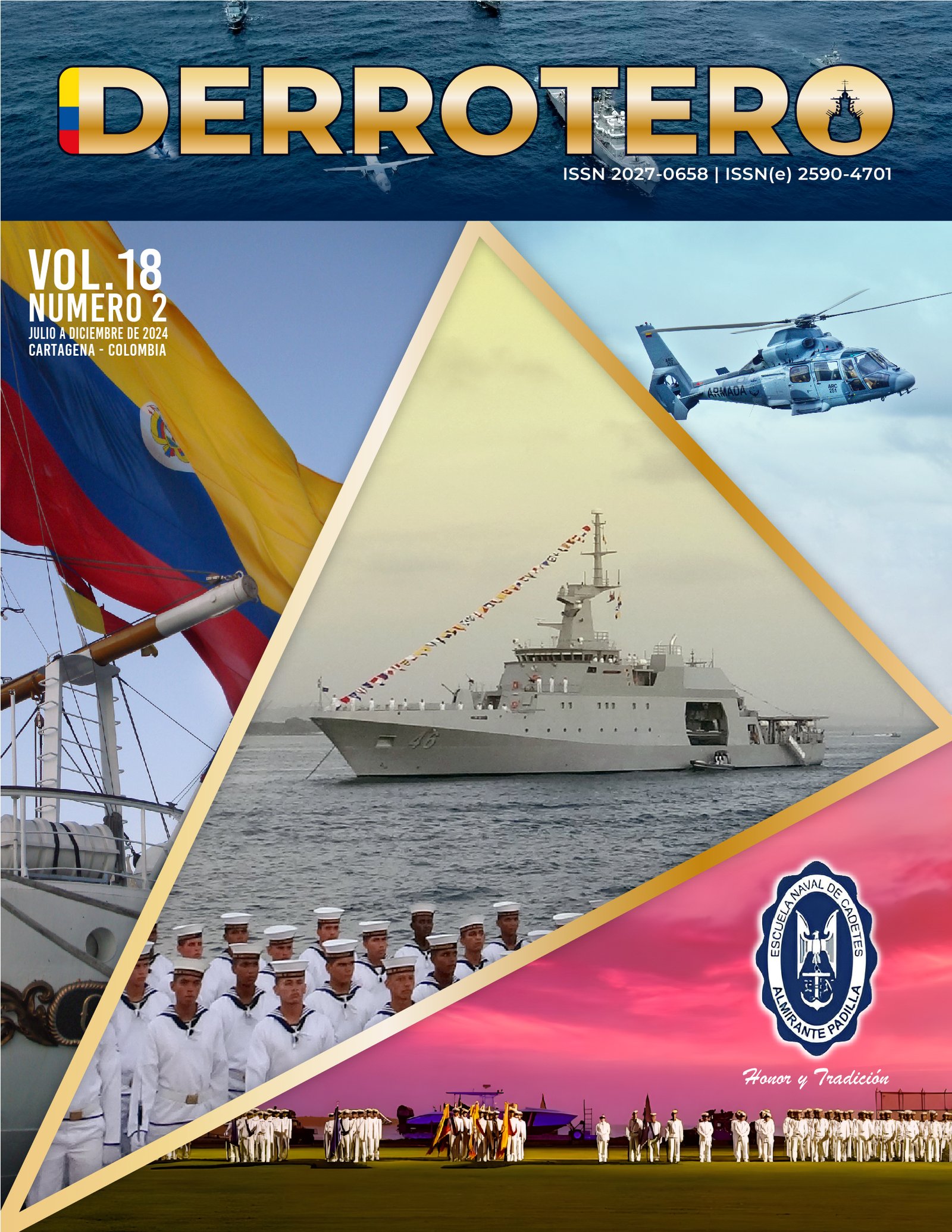Contribution of River Operations to the Care of the Colombian Environment
DOI:
https://doi.org/10.70554/Derrotero2024.v18n02.02Keywords:
Environment, River operations, River basins, Maritime and River interest, Deforestation, Environmental crimesAbstract
This article explores the origin and evolution of Colombia's fluvial doctrine, highlighting its transformation into what is now known as fluvial operations. It includes an analysis of the country’s major hydrographic basins, emphasizing the critical role played by the Marine Infantry Brigades in protecting both renewable and non-renewable natural resources. This approach advocates for a holistic perspective on the environment, recognizing the intrinsic connections between rivers, communities, and the broader ecosystem. Over more than five decades, Marine units have been instrumental in safeguarding thousands of kilometers of navigable rivers, confronting both illegal actors and armed groups that threaten state sovereignty. Their efforts have extended beyond border defense to include the protection of national interests tied to the sustainable use of water resources. However, in recent years, the illicit exploitation of natural resources by armed groups has increased, placing additional strain on ecosystems and heightening environmental vulnerability in fluvial regions. In this context, it becomes imperative to assess whether the troops operating in fluvial environments have developed an ecological awareness that enables them to balance security missions with the protection of the natural environment. Such an approach requires the responsible use of rivers and a comprehensive commitment to preserving the biodiversity of these areas, which are crucial to Colombia’s ecological balance. It is equally important to underscore that specialized training in fluvial operations must remain a strategic cornerstone for positioning Colombia as a global leader in this field. Strengthening these capabilities not only ensures the successful execution of strategic missions but also promotes greater environmental awareness in managing fluvial ecosystems. Finally, integrating fluvial doctrine with principles of ecological sustainability is key to harmonizing national security with environmental conservation in fluvial regions. This approach supports the development of a model in which fluvial operations serve as an effective tool for defending sovereignty while protecting the country’s natural heritage.
References
Alarcón, J. (2015). La tala indiscriminada de árboles en Colombia: Especies en peligro crítico. Revista Ambiental de Colombia. Cinco especies de árboles maderables: caoba, cedro, abarco, palo rosa y canelo de los Andaquíes están reducidos a su mínima expresión en los bosques naturales y su existencia en los suelos colombianos peligra.
Armada Nacional. (2018). Manual de Operaciones Fluviales de Infantería de Marina, cuarta edición. Público reservado.
Archivo del Comité de Instrucción del Centro Internacional de Excelencia Avanzada Fluvial de la Armada Nacional. (2024). Archivo del comité de instrucción del centro internacional de excelencia avanzada fluvial de la armada nacional.
Dirección de Doctrina Naval. (2018). Reglamento de Orden Cerrado para la Armada Nacional, tercera edición. Manual aprobado por el Comandante de la Armada Nacional.
EPM - Empresas Públicas de Medellín. (2021). Proyecto Hidroituango: El proyecto de energía más grande de Colombia. Incluye detalles sobre la construcción de una presa de 225 metros de altura y un embalse de 70 kilómetros de longitud.
Gillingham, F., & Valenzuela, M. (2019). Río tóxico: Minería, mercurio y asesinatos continúan afectando al río Atrato en Colombia. Recuperado de https://es.mongabay.com/2019/11/colombia-contaminacion-en-el-rio-atrato/.
González, L. R. (2013). Las vías fluviales, infraestructuras y puertos: La industria del contenedor, sus aportes al transporte multimodal, visión en Colombia. Recuperado de http://fer.uniremington.edu.co/ojs/index.php/RHS/article/view/29/41.
Hernández, L. A. (2009). Hidrografía colombiana: Río Vaupés. Recuperado de http://amazonasinteractivo.blogspot.com/.
IDEAM. (2024). Instituto de hidrología, meteorología y estudios ambientales de Colombia.
Juárez, F. (2015). La minería ilegal en Colombia: Un conflicto de narrativas. Recuperado de http://www.scielo.org.co/scielo.php?script=sci_arttext&pid=S1657-80312016000100007.
Maps, G. (2022). Google Maps.
News, B. (2024). BBC News.
Ordoñez, J. I. (2020). Río Magdalena, patrimonio de la humanidad. Recuperado de https://unperiodico.unal.edu.co/pages/detail/rio-magdalena-patrimonio-de-la-humanidad/.
Portafolio. (2021). Millonaria incautación de Coltán en Colombia. Recuperado de https://www.portafolio.co/economia/millonaria-incautacion-de-coltan-en-colombia-555168.
UNODC. (2024). Sistema de monitoreo apoyado por UNODC.
Villanueva, C. P. O., Ortega, I. D. R., Tenjo, L. G. P., Álvarez Rodríguez, M. R., & Zuluaga, M. J. L. (2013). Boletín forestal de 2011. Recuperado de http://www.ideam.gov.co/documents/11769/137665/IDEAM+boletin+forestal+2011.pdf/22410822-3011-4bb9-bd5e-f671200d4fe3.
Downloads
Published
How to Cite
Issue
Section
License
Copyright (c) 2024 Briam Escobar Sánchez

This work is licensed under a Creative Commons Attribution-NonCommercial 4.0 International License.
The authors retain copyright and grant the journal the right to publish the work under a Creative Commons Attribution License, which allows third parties to use the published content as long as they credit the author(s) and the publication in DERROTERO.
This work is licensed under a Creative Commons Attribution-NonCommercial-ShareAlike 4.0 International License.










